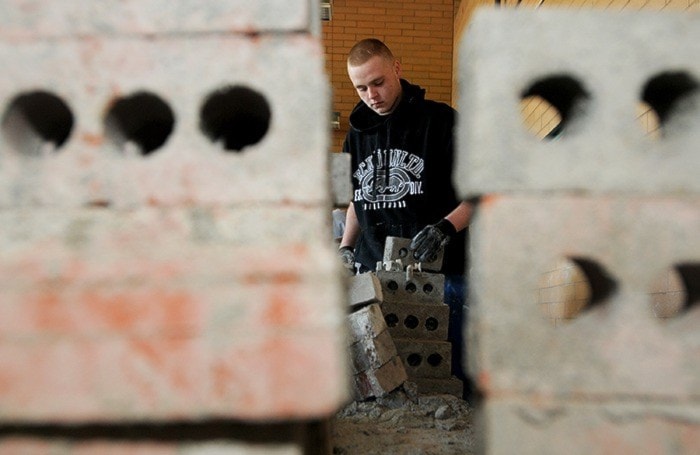Maple Ridge is a blue collar city, with many residents who make a good buck in the building and trades sector, and are happy to steer their sons and daughters in that direction.
That’s the opinion of Steven Wiebe, who is the vice-principal of partnerships and trades programs with the Maple Ridge-Pitt Meadows School District.
The newest trade to be offered is masonry, which just started at Thomas Haney secondary last month. That’s probably appropriate, given that the school’s namesake and city founder was a bricklayer.
There will likely be more trades to come.
Wiebe said the modern trade programs offered in high schools are simply a good deal for students. These are not like their fathers’ old woodwork and metal shop classes. These are offered under the ACE-IT program (accelerated credit enrolments in industry training), which the province uses to push trades.
Firstly, masonry students get a foundational course that would cost them $3,400 for tuition if they attended a post-secondary institution for the training. The government covers the cost for high schoolers.
Secondly, the work they do counts toward their high school graduation credits – so they’re also “doing school.”
And third, these budding masons have upped their pay grade from other starting jobs their peers will take – well beyond the $10.25 a dishwasher might make. They can expect to ask $15 or $16 for their services if they can land a job in the field.
All that said, it’s not the path of least resistance. The guys building brick walls at Thomas Haney will soon have ‘Popeye’ forearms.
Brian De Palma, who is the course instructor through Kwantlen Polytechnic, says bricklaying is the most physically challenging and dirtiest of all the trades.
On the other hand, once it is learned, it is one of the easiest trades to find work in, and a unionized journeyman in B.C. makes $47 per hour. De Palma had to take a pay cut to become a teacher – but says he enjoys teaching, and cares about the future of his trade.
“You can take it to any country,” said De Palma, who has worked at his craft in Australia, New Zealand and England.
He doesn’t see demand for masons diminishing, even as new building materials come into vogue in Canada. Cities consider stone or brick facades a building improvement, and planning departments around the Lower Mainland promote masonry in residential subdivisions and commercial developments. Even gas fireplaces are still installed with some masonry around them, he points out.
De Palma was the project manager who oversaw the masonry work for the Target renovations at Haney Place Mall.
His enthusiasm for brick and stone is rubbing off on his students.
“I love it,” said Grade 12 Brad Komar. “It’s hands-on, the people in it are good people, and it’s a crazy [good] opportunity.”
Student Tony Wilkinson said the “classroom” is more like a job site.
“He [De Palma] treats it like a workplace environment,” Wilkinson said. “It’s hands-on, and it’s easy to get the hang of.”
They are the next generation of masons, and their services will be in demand. The average age of a mason in the province is 57, according to a survey done nine years ago, said Wiebe.
“They’re retiring, and there’s nobody to replace them.”
Wiebe sees the trades can be a fast track to a good lifestyle for many young people. He points to the likes of Garibaldi graduate Diana Yale, who is almost a red seal electrician at the age of 21. She splits her time between working in Northern B.C., and traveling to places like South America.
The trades are also great options for students who know they are not university bound.
Students in School District No. 42 can take carpentry and metal fabrication courses, as well as those to be an electrician or automotive service technician. Plumbing is in just its second year at Garibaldi. They district also offers culinary arts and hair design.
“The next one I would really like to go for is automotive collision repair,” said Wiebe.
He noted government grants are made available to cover startup costs, and his job is to set up a partnership with a post-secondary institution that can offer foundational training.
Wiebe noted there are seven major projects in B.C. that will create heavy demand for skilled trades.
“There are real wages to be made,” said Wiebe. “The demand is going to be there for years to come.”
